SCIENTIFIC AND EMPIRICAL PROOF THAT THE STORYALITY™ THEORY WORKS: `THE DEVIL INSIDE’ (2012)
The StoryAlity™ Story/Screenplay/Film Theory makes certain predictions about a story/screenplay/film, and its probable virality.
(i.e. The likelihood of it `spreading like a virus in the culture’, due to: word-of-mouth.)
This `film virality’ can empirically be measured, as: RoI (Return on Investment).
The RoI bell curve. Note that only the GREEN films here actually make money. (i.e. 7 in 10 films lose money-!)
StoryAlity™ is therefore: a probability calculus, and more importantly (if you are a screenwriter, filmmaker, or anyone in the film industry) is also:
A Set of Guidelines – for all Feature Film Screenwriters/Filmmakers.
In fact, for anyone in the film industry. I hope it helps you.
i.e.: When we analyse the Common Characteristics in the Story/Screenplay/Films of the Top 20 RoI Films of the Past 70 Years, a very clear set of Story/Screenplay/Film Guidelines results from this empirical data.
(Ignore them at your own peril.) The StoryAlity™ Theory can increase the probability of your story/screenplay/film, going viral.
The film that is scientific proof (ie. using The Scientific Method) of the Guidelines, and of StoryAlity™ Theory itself, is: THE DEVIL INSIDE (2012).

The Devil Inside (2012)
In 2012, The Devil Inside entered the Top 20 ROI Films List, thus verifying the StoryAlity™ Theory…
THE TOP 20 RETURN-ON-INVESTMENT FILMS (as @ May 2013)
|
# |
MOVIE |
BUDGET |
WORLDWIDE GROSS |
% ROI |
| 1 | Paranormal Activity | $15,000 | $196,681,656 |
1,311,211 % |
| 2 | Mad Max | $200,000 | $99,750,000 |
49,875 % |
| 3 | The Blair Witch Project | $600,000 | $248,300,000 |
41,383 % |
| 4 | El Mariachi | $7,000 | $2,041,928 |
29,170 % |
| 5 | Night of the Living Dead | $114,000 | $30,000,000 |
26,316 % |
| 6 | Rocky | $1,000,000 | $225,000,000 |
22,500 % |
| 7 | Halloween | $325,000 | $70,000,000 |
21,538 % |
| 8 | American Graffiti | $777,000 | $140,000,000 |
18,018 % |
| 9 | Clerks | $27,000 | $3,894,240 |
14,423 % |
| 10 | Once | $150,000 | $18,997,174 |
12,665 % |
| 11 | Napoleon Dynamite | $400,000 | $46,140,956 |
11,535 % |
| 12 | Open Water | $500,000 | $55,116,982 |
11,023 % |
| 13 | Friday the 13th | $550,000 | $59,754,601 |
10,864 % |
| 14 | The Devil Inside (2012) | $1,000,000 | $99,661,944 |
9,966 % |
| 15 | Saw | $1,200,000 | $103,096,345 |
8,591 % |
| 16 | Primer | $7,000 | $565,846 |
8,084 % |
| 17 | The Evil Dead | $375,000 | $29,400,000 |
7,840 % |
| 18 | ET: The Extra-Terrestrial | $10,500,000 | $792,910,554 |
7,552 % |
| 19 | The Full Monty | $3,500,000 | $256,900,000 |
7,340 % |
| 20 | Star Wars | $11,000,000 | $797,900,000 |
7,254 % |
| 21 | My Big Fat Greek Wedding | $5,000,000 | $353,900,000 |
7,078 % |
Original Data Source: http://www.the-numbers.com/movies/records/budgets.php
Data courtesy of Nash Information Services, LLC (www.the-numbers.com).
In 2012, The Devil Inside entered the Top 20 ROI Films List,
thus verifying the StoryAlity™ Theory.
(Note that this entry of THE DEVIL INSIDE into the top 20 RoI list also: `bumps’ MY BIG FAT GREEK WEDDING down to: #21.)

My Big Fat Greek Wedding (2002) – a Top 20 ROI Film, and a wonderful film story: in fact – one of the most viral film stories ever.
In StoryAlity™ Theory – To calculate a film’s Return On Investment:
Divide the box office (worldwide gross) by the film’s PRODUCTION budget and then multiply by 100. This is the R.O.I., expressed a percentage.
(For e.g.: a 300% ROI means, a film made 3 times its budget)
Note that – to make the Top 20 list, a film must have an RoI of at least 7,254 % (must make, over 73 times its production budget.)
– Most Hollywood successful “blockbusters” only make a 1000% R.O.I.
(And – only 3 in every 10 films makes money.)
A SUMMARY OF THE StoryAlity™ GUIDELINES:
A summary of StoryAlity™ Theory.
A summary of the StoryAlity™ Guidelines (for screenwriters, filmmakers, etc) of the Top 20 ROI films – up to and including 2011 – are, as below.
And also, below this – is also a comparison of characteristics of THE DEVIL INSIDE (the film which entered the Top 20 ROI Films list, in 2012) to test how accurate the StoryAlity™ Theory Guidelines are.
(Note: They are extremely accurate, i.e. the StoryAlity™ Theory has not yet been falsified.)
This process is called: The Scientific Method.
(Note also that: most popular – and academically-cited – screenplay manuals do not use either: an Empirical – nor a Scientific Method).
SO – WHAT EXACTLY, DOES THE STORYALITY™ THEORY PREDICT?
Loads of stuff.
StoryAlity™ Theory states that: a film with the following characteristics has the greatest probability of going viral – in other words – of reaching the widest audience for the least film production budget.

The Devil Inside (2012)
BRIEF StoryAlity™ ANALYSIS – THE DEVIL INSIDE (2012):
1) Two-Part Structure – Yes. In the film `THE DEVIL INSIDE’, everything is going well for Isabella – until the 37% mark of the story (page 28 of the screenplay /minute 28 of the film). After that: it’s all downhill. (Aristotle actually noted that Ancient Greek tragedy plays conform to this 2-part structure. Though I don’t know that his method in analyzing Greek tragedies was actually empirical or scientific. Which is ironic – since he also popularized The Scientific Method. – I have read lots of translations of `Poetics’ and I don’t see any evidence of an empirical method there. So it all may be a coincidence that Aristotle’s 2-part structure matches the Top 20 RoI Films’ structure. Note: Aristotle never said anything about `3 Acts’. Seriously. Check it.)
2) A Villain Protagonist – the demon (in fact, multiple demons) possess Maria Rossi. Everything else in the story is `the antagonists’ (Maria, Michael, Ben, David) reacting to the actions that the demons (protagonists) take.
(Note: many Horror Genre and Action films also work this exact way… see: Hans Gruber in DIE HARD, and also see all the James Bond films, etc. The Villain starts out taking the first action – and then, `drives’ the story, and the hero `reacts’ to each of the events.
So the Villain and the Hero are actually: `Protagonist’ and `Antagonist’, respectively. This goes against `the screenwriting convention’, but then again – so does most of StoryAlity™ Theory. The reason for this is that the `screenwriting convention’ does not use an empirical nor scientific method, and so – it is probably: mostly wrong.)

Do not adjust your set. The Villain is actually: the Protagonist. The Hero is the Antagonist. Seriously.
3) A `Villain Triumphant’ story – the demon/s win in the end, and the good guys lose. (In fact, SPOILER ALERT: they lose: their lives.)
4) No Character Arcs – Isabella and Michael, and Fathers Ben and David (and even Maria Rossi for that matter) do not `change/grow’ in the story. In fact – they all just: die. Forget about Character Arcs. Those are for `Drama’ Genre films – and there are none of those in the Top 20 RoI Films. (i.e. Dramas. And there are 7 of them in the Bottom 20 ROI – i.e. Biggest Money Losing Films. Dramas are a huge worry.)
5) The 3 Primal Themes – yes. The film contains these, as per StoryAlity™ Theory. i.e. a) Life & Death, b) Family & Community, and c) Justice. (See below for more details.)
6) Set in the Present Day – Yes. (i.e. 2009. Though the film was released in 2012, this is still essentially The Present Day, i.e. this is not a `Period Piece’, say, set 10 years or more prior to The Present Day.)
7) Temporally Linear – Yes. The film does not use a non-linear structure (such as Pulp Fiction, Rashomon, or Memento), even though, Super-8 and digital footage is shown of the past in the film.
8) A Love Story – There is a `Romance’ subplot of sorts, though – being a Horror Genre film, it is pretty messed up – and actually involves: a secret pregnancy termination.
9) A Writer-hyphenate – yes. A Writer-Director: William Brent Bell was the Co-Writer and Director. StoryAlity™ Theory shows: all the top 20 RoI films are by writer-hyphenates. (i.e.: Either a Writer-Director, a Writer-Producer, or a Writer-Actor, and sometimes all 3 at once.) This (the `Writer-hyphenate’ thing) is one of the 100 or so findings (new contributions to Knowledge) of the StoryAlity™ Theory. Films are tricky. It is better for the Writer to be involved in production, and be there when the Vision is being realized – rather than just “pass a script off to a Director ” to realize onscreen. The written word (a screenplay) is such an abstraction. Films are sound and image – not “written words”. (Well, except if you also have inter-titles.)
10) StoryAlity™ 10-Act Plot Structure. (See: the StoryAlity™ Syntagm below.)
THE DEVIL INSIDE (2012)
|
ACT |
% |
MIN/ PAGE |
STORY EVENT |
STORYALITY™ BEAT |
|
1 |
1 % |
1 |
Title card: October 30, 1989 – A 911 (confessional) call is made by MARIA ROSSI, about the murder of three people… | …The Hero at home/work/base |
|
2 |
2 % |
2 |
A Police Officer narrates the crime-scene footage: the Rossi house is in “disarray”… | …An Ally complains |
|
3 |
5 % |
4 |
An officer explains: the 3 murders occurred during a church meeting at the Rossi house; they don’t wish to speculate on the cause… | …An Obstacle appears |
|
4 |
8 % |
6 |
The documentary filmmaker Michael explains the reason for the documentary about Maria Rossi: her daughter Isabella wants answers… Why did her mother commit a triple homicide in 1989? | …Pursuit / “The Chase” |
|
5 |
14 % |
10
|
Father Gallo gives a lecture to the student clergy in Rome about exorcism, and explains about “Multiple Demonic Possession”, where a demon “jumps” from one person to another. The students debate whether possession is demonic, or, mental illness… | …The Shape of Things to Come & the Thematic Dialog / `Dramatic Irony’ line |
|
6 |
23 % |
16 |
Dr Costa explains not to talk about religion in front of Maria, as it disturbs her. Archival footage is shown of: Maria attacking Dr Costa when he mentions religion… Dr Costa claims ignorance of why Maria was transferred to Rome. | …Trouble in Paradise |
|
7 |
38 % |
28 |
Isabella reveals that, impossibly, her mother Maria knows about her own – secret – abortion, 4 years prior. Fathers Ben and David note Maria’s clear signs of possession. | …Paradise Lost |
|
8 |
61 % |
44 |
They decide to perform an exorcism on Maria Rossi, despite that it is illegal, and will jeopardize Father David’s job… | …The Descent into Hell |
|
9 |
85 % |
61 |
Father David enters the house – now clearly possessed… He attacks Father Ben, takes the police officer’s gun – and when he commits suicide, the demon jumps into Isabella. Father Ben must try and battle the demon, to save Isabella’s soul. | …The Battle Royale |
|
10 |
100 % |
72 |
Michael, Ben and Isabella are all killed in the car crash. | …The Villain Triumphant |
Note, re: Act 5 – The Shape of Things to Come & the Thematic Dialog / Dramatic Irony line: At the 14% mark, Father Gallo explains about: “Multiple Demonic Possession”, where a demon “jumps” from one person to another. The clergy students then debate whether possession is: demonic, or, mental illness. This foreshadowing /dramatic irony is fulfilled in the film story, from Act 7 onwards.
And, for an identical StoryAlity™ Story Structure analysis of the other Top 20 ROI Films, see this post.
StoryAlity™ Theory – SPECIFIC DETAILS
Here are the specific details that StoryAlity™ Theory reveals, from a study of the Top 20 RoI Films of the Past 70 Years.
(This is incredibly useful – if you are a Screenwriter/Filmmaker, and hope to create a film that goes viral, like all the Top 20 RoI Films did.)
A COMPARISON OF `THE DEVIL INSIDE’ (2012) TO THE STORYALITY™ PREDICTIONS
|
CRITERIA |
TOP 20 ROI Average |
RANGE (Top 20 ROI Films) |
THE DEVIL INSIDE |
CONFORMS: Y/N ? |
|
Genre |
Horror (mode / most frequently occurring Genre) |
Horror Comedy Sci-Fi Sports Nostalgia Musical Gangster |
Horror |
Y |
|
Number of Main Characters |
4.4 |
2 – 9 |
4 (Isabella, Michael, David, Ben) |
Y |
|
Occupations of the Main Character/s |
Working class / students (both = mode) |
See Table on “Occupations” |
Working class/ Students (student priests) |
Y |
|
Character Arc/s” in a high ROI film Story |
None |
None |
None |
Y |
|
Number of Story Acts (StoryAlity™ Syntagm) |
10 |
10 – 10 |
10 |
Y |
|
StoryAlity™ Story Structure Monomyth |
STORYALITY™ Syntagm |
STORYALITY™ Syntagm |
STORYALITY™ Syntagm |
Y |
|
Story Ending |
Villain Triumphant |
Villain Triumphant |
Villain Triumphant |
Y |
|
Screenplay / Film Length |
92 pages / 92 minutes |
77 -121 pages/mins |
72 mins |
N |
|
# of Scenes |
119 scenes |
71-189 scenes |
155 |
N |
|
Avg Scene Lengths |
49 seconds |
1 sec – 14mins 25 s |
28 secs |
N |
|
Ratio of Ext/Int scenes |
44% Ext / 56% Int |
(3 – 95) Ext (25 – 121) Int
|
Ext =20% / Int – 80% |
N |
|
Number of Locations |
29 |
2-73 |
69 |
Y |
|
Types of Main Locations/Settings |
Domestic / urban |
See: Types of Top 20 ROI Main Locations |
Domestic / urban |
Y |
|
Time period / Temporal Setting |
Present |
Past, Present, Future |
Present |
Y |
|
Story Ending |
Villain Triumphant |
Villain Triumphant |
Villain Triumphant |
Y |
|
Theme |
Survival, Reproduction, Revenge |
Survival, Reproduction, Revenge |
Survival, Reproduction, Revenge |
Y |
|
Sex scenes |
40 % |
8/20 films |
N |
Y (less than 50% chance) |
|
Chase scenes |
85 % |
17/20 films |
N |
Y |
|
Shootouts |
45 % |
9/20 films |
N |
Y |
|
Fight scenes |
75 % |
15/20 films |
Y |
Y |
|
Montage/s |
11/20 films |
11/20 films |
Y |
Y |
|
Expected Reviews/Critics Ratings? |
73% |
46%-94% |
18% |
N |
|
Expected Oscars® |
6% chance |
2/20 films |
0 |
Y |
|
Expected MPAA Rating |
R |
PG – UR |
R |
Y |
|
Length of Shoot
|
34 days |
7 – 80 days |
? |
? |
|
“Look” of the film |
Color |
Color/ B&W 35mm, 16mm, digital |
Color, digital |
Y |
SOME DETAILED EXPLANATORY NOTES ON THE ABOVE:
1) Nine of the Top 20 ROI Films are in the Horror Genre – THE DEVIL INSIDE (2012) also conforms to this expectation/prediction of the StoryAlity™ Theory. i.e. A Horror Film is “the most probable Genre” of film, to enter the Top 20 ROI Films List. (To enter the list, a film has to make over 70 times its Production Budget, or a 7,000% RoI.)
2) The Number of Main Characters – (The StoryAlity™ Theory Guidelines suggest: 4 characters – 3 main characters, and one villain, based on the study of the Top 20 RoI Films). In THE DEVIL INSIDE is also considered (by this author) to have 4 main characters, as Maria Rossi’s screentime in the film does not mean she qualifies as a main/`major’ character. Note also that: Father David and Isabella also become `villains’, when possessed.
3) The Occupations of the Main Character/s – StoryAlity™ Theory says: the most probable occupation for main characters in a Top 20 ROI Film is: students/working class. As per the predictions of the StoryAlity™ Theory, the two Fathers (Ben and David) are indeed student priests, and Isabella and Michael (the documentary filmmakers) are also working class.
4) Character Arc/s” in a high ROI film Story – Whereas many popular `screenwriting manuals’ suggest `Transformational Character Arcs’ – StoryAlity™ Theory indicates no such thing. In fact, the opposite: Character Arcs are NOT required for a viral (high RoI) film. Indeed, the main characters in THE DEVIL INSIDE do not undergo Character Arcs/Transformation, as `becoming possessed’ is not: a character `growth’. It is: demonic possession. (While possibly amusingly literal, to consider possession by a demon a `character change’ would miss the point of what the popular Hollywood `screenwriting manuals’ prescribe. Noting that – the popular Hollywood screenwriting manuals also do not use an empirical nor scientific method – as does StoryAlity™ Theory.)
5) Number of Story Acts – There are demonstrably 10 `Acts’ in THE DEVIL INSIDE. See the StoryAlity™ Syntagm above, for more on the story/plot structure of all Top 20 R.o.I. Films.
6) The StoryAlity™ Syntagm – see above. (And `as above: so below’…)
7) The StoryAlity™ Story Structure Monomyth – see above.
8) Screenplay / Film Length – as per StoryAlity™ Theory – the average length of a Top 20 RoI Film is 92 screenplay pages/92 minutes. However the Range of the Top 20 RoI Films is: between 77 minutes (i.e.: Primer, 2004) and 121 minutes (Star Wars, 1977). Notably, THE DEVIL INSIDE is much shorter than this length – at 72 minutes, (or 79 minutes, if we include the 7 minutes of End Credits.)
9) Number of Scenes – There are 155 scenes in THE DEVIL INSIDE. The Average Number of Scenes in a Top 20 RoI film is 119, and the Range of the number of scenes in Top 20 RoI Films is from 71 scenes (Once, 2007) to 189 scenes (Star Wars, 1977).

The Top 20 ROI FIlms – Screenplay Pages vs Total Film (Screenplay) Duration in Minutes (Pages): The Elliot Wave
10) Average Scene Lengths – StoryAlity™ Theory shows that the average scene length of a Top 20 RoI film is 49 seconds. The average scene length in THE DEVIL INSIDE is 29 seconds, making it: a very fast-paced film. (I blame MTV). See the detailed Scene Stats breakdown tables (further down below), for more on this. (i.e.: If you are a hardcore screenwriter 🙂
11) The Ratio of EXTerior to INTerior scenes – in THE DEVIL INSIDE (20% Ext/80% Int) is quite an interesting result, given that the #1 ROI Film, Paranormal Activity (2009) is set 100% indoors (Interior scenes). Films with more INTeriors are in general cheaper to shoot, and this keeps the production cost down – and therefore obviously increases the odds of a high RoI for any given film, all things being equal. (In the film industry, this is also called: `Common Sense’.)
12) Number of Locations – There are 69 unique locations (i.e.: that would require new camera setups to shoot) in THE DEVIL INSIDE. – While this is not very close to the `average number of locations’ in a Top 20 RoI film, it is still within the Predicted Range (2 to 73 unique locations/camera setups). This merely shows the film THE DEVIL INSIDE `moves around’ a lot, in terms of its locations. Variety. The spice of life, they say.
13) Types of Main Locations/Settings – as per Probability, and the predictions of StoryAlity™ Theory, the main settings of THE DEVIL INSIDE is: Urban – and Domestic (e.g. Rome, and the priests’ house, the Centrino Mental Hospital, a Hotel, etc.).
14) Time period / Temporal Setting – as per the prediction of StoryAlity™ Theory, the film is set in The Present Day (in the context of when it was produced/screened, although, it also includes Flashbacks to 1989, from `the present day’ of 2009). Two other films in the Top 20 RoI have flashbacks: Halloween, and Friday The 13th. But they are not really Flashbacks there – as the films start with them. Also I guess Primer is all one big Flashback, but that’s because it’s: a Time Travel film. (And probably the most intelligent one, ever made. Have you seen it? It’s awesome.)
15) Story Ending – (spoiler alert) – as per the prediction of StoryAlity™ Theory, and as with all Top 20 RoI films – THE DEVIL INSIDE has a `Villain Triumphant’ ending. i.e.: The “good guys” do not win. – In fact, like many Top 20 RoI films, at the end, the good guys are, instead: just plain, dead.
16) Theme – as per StoryAlity™ Theory, as a Top 20 RoI Film, the three main Themes of THE DEVIL INSIDE are: Survival, Reproduction, Revenge – (or in other words, the Themes of: Life & Death; Family and Community; and Justice).
a) Life & Death: Isabella and the documentary cast and crew face Life and Death (in dealing with: multiple demonic possession);
b) Family & Community: Isabella seeks to uncover the mystery of her mother’s crime, and also rescue her mother from the Centrino Mental Hospital; and
c) Justice: Isabella and Michael seek the truth – and justice – for Maria Rossi. Was she insane, or just possessed? The story logic is: If possessed she shouldn’t be in a Mental Hospital, she should instead be exorcized. i.e.: `The Devil Made Me Do It.’ (Stoopid Devil. I hate that guy.)
17) Sex Scenes – given that only 8 out of the 20 Top 20 RoI Films (or: 40% of them) feature a Sex Scene, the fact there is NO (onscreen) sex scene in THE DEVIL INSIDE accords with probability – and indeed, with the StoryAlity™ Theory. A Sex Scene is really not necessary, in order to have a Top 20 RoI Film. (Not that there’s anything wrong with sex scenes in cinema, though. I love all that stuff.)

This Love Scene would never pass the Hays Code of Motion Picture Production (1930). You had to keep one foot on the floor.
18) Chase Scenes – likewise, given that only 17 out of 20 (or 85%) of Top 20 RoI Films have an explicit Chase Scene (be it: on foot, or in vehicles, etc) the fact that there is not one in THE DEVIL INSIDE doesn’t really mean much. i.e. Who cares?
There are some “race against time” scenes in THE DEVIL INSIDE (in the hospital when Isabella is possessed, and when they are racing to get the possessed Isabella to Father Gallo, for an exorcism), and, maybe these could be considered Chase Scenes but – they more a `Timelock;. i.e. They are not actively chasing – where the pursued party is running away/seeking to evade them. For this reason – these scenes are not considered “Chase” Scenes in the true sense of the term.
Before it entered the Top 20 RoI list, (coming in at #14, when it did), there was an 85% chance/probability that THE DEVIL INSIDE would have a Chase Scene in it, but – since it actually does not, it falls into the 15% probability of: there NOT being a Chase Scene, and so – in fact: there isn’t one.
(Sorry for a long-winded over-explanation, but I am intending to demonstrate clearly here – in this analysis of how THE DEVIL INSIDE compares with the predictions of StoryAlity™ Theory – just how probability and StoryAlity™ Theory works. Some people struggle with `How Probability Works’, and I am trying to help them understand it better. See also, Nassim Taleb’s awesome book FOOLED BY RANDOMNESS.)
Or – To be clear: use StoryAlity™ Theory to write you screenplay/make your film, if you want to increase the probability of it going viral, in theatrical cinema release.
19) Shootouts – likewise, there are no Shootouts in THE DEVIL INSIDE. (As per StoryAlity™ Theory, there was only a 45% probability that there would be, in the film.)
Note: I do not actually consider the scene where Father David Keane shoots himself, a `shootout’. By definition, a `shootout’ would involve: two opposing parties, both shooting at each other. (I suppose, since Father David is potentially possessed by multiple demons at that point, there could in fact be two or more `parties’ involved, and yet, in that scenario: only one of him has a gun.)
20) Fight scenes – there are indeed Fight Scenes (in fact, multiple fight scenes) in THE DEVIL INSIDE, and good old StoryAlity™ Theory has predicted a 75% chance of this (there are fight scenes in 15 of the Top 20 RoI Films). So – on this one, the numbers are with us. There are multiple times in the filmovie, when people fight with other people who are possessed.
21) Montage/s – yes, there are MONTAGES (i.e.: a SERIES OF SHOTS, to show time passing) in the film. There was also a 55% chance of this, and given probability (and: StoryAlity™ Theory), and this film won the coin-toss. (It was, after all, a slightly `loaded’ coin. i.e. 55%. Most coins are only: 50%).
22) Expected Reviews/Critics Ratings? – On MetaCritic.com, THE DEVIL INSIDE got absolutely hammered. It scored a whopping 18% (from 19 Critics Reviews), and yes I am being sarcastic now, as that score is hardly `whopping’.
But – what this shows is that – to have a Top 20 RoI Film – you do not even have to make a film that The Critics even remotely, like. (The next least-well-reviewed film in the Top 20 RoI was the original SAW (2004), at 46% on MetaCritic.)
The filmovie THE DEVIL INSIDE was harshly reviewed also, as, it was felt by many to have “the worst ending for a movie, ever” (where: the film `suddenly’ ends with the shocking car-crash tragedy – and then a link to the `TheRossiFiles’ website. This was seen by many as a cynical Transmedia exercise. Maybe it was. Who knows.)
The point is, `critically-successful’ and `commercially-successful’ films are rarely: the same film.
For more, see the excellent book GREAT FLICKS: Scientific Studies of Cinematic Creativity and Aesthetics (2011) by DK Simonton. And see this post for more.
23) Expected Oscars® – Nobody in their right mind expects an Oscar® for this film. As above, and as per StoryAlity™ Theory, since only 1 film in the Top 20 RoI has ever won the AMPAS Best Picture Oscar (Rocky, 1976) and one also got it for best song (Once, 2007), the likelihood/odds/probability of a Top 20 RoI film ever getting an Oscar is deeply remote. And again, good old StoryAlity™ Theory comes up trumps, and THE DEVIL INSIDE gets about as close to an Oscar® as Sarah Palin gets to ever saying anything that makes any sense at all.
24) Expected MPAA Rating – THE DEVIL INSIDE is Rated `R’. Restricted. It’s a Horror film. 9 of the Top 20 RoI films are also Rated R – which means, a Top 20 RoI Film has a 45% chance of being R-Rated. (Also, 4 of them are UR or NR – UnRated or Not-Rated, ie refused a Rating.)
This (the inclusion of Unrated and Not-Rated) also pushes the probability up to 13/20, or a 65% chance of being an R-Rated film (after some cuts to make those censors happy). And – true to probability and to StoryAlity™ Theory (which are in fact – the exact same thing) the odds play out totally as expected. Once again – we see both the genius – and the simplicity – of StoryAlity™ Theory at work. I see I have not yet been nominated for a Nobel Peace Prize for this (i.e. for StoryAlity™ Theory), but – all the forms are here, if you would like to do so: http://www.nobelprize.org/nobel_prizes/peace/nomination/
25) Length of Shoot – I haven’t been able to research – nor figure out by other means (such as, say, an abacus) – how long the Shoot on this film actually was. But – the Range of Top 20 RoI films is: between 7 and 80 days, with an average of: 34 days.
So I am going to guess, it was roughly around about: 34 days exactly. If anyone knows the exact number of Shoot Days for THE DEVIL INSIDE, then please Comment below – or, even Email me, or whatever. You can contact me here.
26) “Look” of the film – StoryAlity™ Theory predicts, a Top 20 ROI film will be: Color and Digital, and indeed, THE DEVIL INSIDE is: this.
Hey Presto, StoryAlity™ Theory comes through with the goods – yet again.

27) On Frequency – StoryAlity™ Theory predicts: a Top 20 ROI film will come along every 2.05 years, on average. THE DEVIL INSIDE (arriving in January 2012) was slightly late (i.e.: 3 months after it was due, that given Paranormal Activity arrived in October 2009). Note that StoryAlity™ Theory predicts: a Top 20 ROI film will come along in 2014.
And for more on The Frequency of Top 20 RoI Films, see this post.
28) `Found Footage’ – previously there were 2 films in the top 20 RoI that are `Found Footage’ Documentaries: The Blair Witch Project and Paranormal Activity. This film makes it three.
So a `Found Footage’ film now has a 15% chance of entering the Top 20 RoI.
29) `The Something Something’ Titles – There are now three films in the Top 20 RoI with a title in the format of: `The Adjective Noun’ (though, not necessarily in that order). i.e.: The Evil Dead, The Full Monty, and now, The Devil Inside.
(See the diagram below for the holarchy of the film meme.) i.e. These are some of the ways a Film Meme spreads. e.g. The Title, via word-of-mouth (“Have you seen [insert Film Title]? It’s awesome…”; or we see a Film Poster; or we see the Trailer, etc)
So – no matter what your film is about, if you title your film that way (“The Adjective Noun”) – it then has a 15% chance of entering the Top 20 RoI. (I am kidding. This is a joke. A title alone is not what makes a film go viral, though it helps, as it is part of the memeplex of the film. You also need to do about 30 other things right, to make your film go viral. See: StoryAlity™)
Also, note randomly, that `Star Wars’ was originally titled: “The Star Wars”. (As was that social media tool: The Facebook.)
30) Top 20 RoI films are trending towards: 90 minutes in length. And – an Average Scene length of: 1 scene per minute / 1 screenplay page. (NB – That is: an average…)
And – If you know of a better Screenwriting/Filmmaking system to ensure you film goes viral, then – go to it.
Otherwise, maybe even, buy the book: StoryAlity™.
And: spread those memes like a virus!
DETAILED SCENE STATISTICS – THE DEVIL INSIDE (2O12)

The Devil Inside (2012)
COMPARISON OF THE DEVIL INSIDE (2012) – SCENE STATS
Okay, this bit is just for hardcore screenwriters. (Skip this section if you are not one of us.)
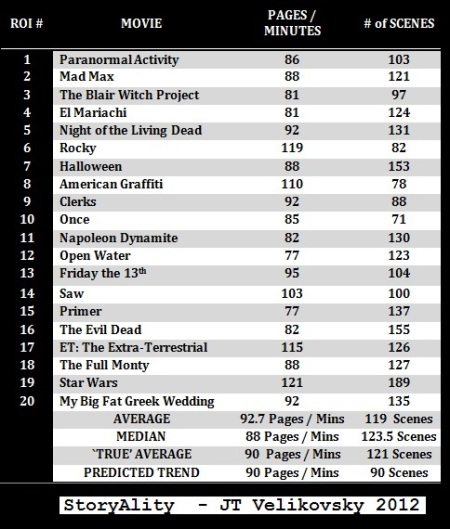
Top 20 RoI Films – Scene Lengths
The Scene Stats below show that THE DEVIL INSIDE correlates to the StoryAlity™ guidelines. Note that:
1) It is a much faster-paced film than the average Top 20 ROI Film. (It has a shorter average scene length; the average Top 20 ROI Scene length is 49 secs, THE DEVIL INSIDE average scene length is 28 secs)
2) The longest scene in the film is twice the length of the average Top 20 RoI film’s average longest scene. This is the scene begins in minute (or, on screenplay page) 33, the `Exorcism of Rosa (Basement)’ scene. This takes up the 46%-56% mark of the film.
3) At a running time of 72 minutes (approx. 72 screenplay pages) this is even shorter than Primer, at 77 minutes. (Note that THE DEVIL INSIDE is 79 mins, if we include the 7 mins of End Credits.) So not only is THE DEVIL INSIDE faster-paced than the average Top 20 ROI Film, it is shorter as well.
These statistics for the film also bring the averages of Top 20 ROI films closer to another prediction of StoryAlity™ Theory, namely: a film length of 90 minutes.
|
THE DEVIL INSIDE (2012) |
MIN : SEC |
SCRIPT PAGES |
|
Average Scene Length |
0:00:28 |
½ a page |
|
Longest Scene: |
0:07:28 |
7 and ½ pages |
|
Shortest Scene: |
0:00:02 |
One line |
|
Median Scene Length |
0:00:09 |
1/8th page |
|
Mode Scene Length |
0:00:02 |
One line |
Phew. Okay, it’s over.
(i.e.: That section was just for the hardcore screenwriters.)
AN IRRELEVANT SIDE NOTE – ON MY PERSONAL OPINION on: THE DEVIL INSIDE (2012) AS A FILM.

Q: Do I happen to personally think, THE DEVIL INSIDE is actually: a great film?
A: Who cares?! My personal opinion on the film itself is: totally irrelevant.
And so is yours.
Now – I know this is a hard idea to get your head around with this stuff, but: here it is:
OPINIONS DO NOT MATTER.

Abandon Aristotle – and his stoopid Old opinions on `Drama’. Embrace Empirical Facts and The Scientific Method. Every other Discipline but Screenwriting abandoned Aristotle centuries ago. Seriously.
What matters in film, are: EMPIRICAL AND SCIENTIFIC FACTS.
If there are 30 Common Elements to the Top 20 ROI Films (which The StoryAlity™ Theory explains) – then – don’t you want to know what they are?
(So that – you too can maybe increase the probability of your own screenplay/film going viral?)
Wait, don’t even bother to answer that.
(If you don’t mind that: 7 in 10 films lose money, and that 98% of screenplays presented to producers go unmade, then by all means – ignore all this stuff.)
The point is, opinions don’t matter.
To be uber-clear:
The form of the Top 20 RoI films is: identical.
The content – in each case – (in each of the Top 20 RoI films) is different.
…You can use `the Form’ – and then fill it, with your own Content.
Q: But wait, surely, by using The StoryAlity™ Screenplay System – eventually you’d get formulaic, and homogenous, and entirely-predictable storylines. I’m thinking there were be little or no contrast between one script to the next – because basically, you’d have: `movies by committee’..?
A: Are you nuts? Hollywood already “makes movies by committee” – and most of them empirically suck (as: 7 in 10 of them lose money). – Right?
So – if you really think all that (i.e.: the above) – then you are still missing the whole point of StoryAlity™:
StoryAlity™ supplies the Form – that, empirically, has the highest probability of going viral.
YOU supply the Content. (When you create your Story – using StoryAlity™).
And – if you think of: The Hero’s Journey (Campbell or Vogler), or of Syd Field’s system, or Linda Seger’s system, or Robert McKee’s system (etc etc etc) – movies already are super-formulaic.

A bunch of popular screenplay manuals – that do not use the Scientific nor Empirical Method. They make up theories and then use `illustrative examples’. If they are right, then that is a lucky coincidence.
Movies are the most formulaic form of writing there is!
(If you have assumed you can write a movie just to express yourself alone, you have assumed wrong. Movies do not work that way. They are expen$ive. Film Financiers don’t cough up a film budget purely on the basis that: some writer “expressed themself”. Film Investors are all risk-averse, especially as 70% of movies lose money – and they do not want to lose their money. …Does anyone?)
It’s also that: the other existing `formulas’ (screenplay manuals) themselves – aren’t actually based on Empirical Facts – nor The Scientific Method. (For more on that see this post.)
(and did I mention that StoryAlity™ totally is?) – ie Empirical, and Scientific?
All of which, is probably why, due to the existing (and: dubious) `screenwriting convention’:
a) 7 in 10 movies lose money
and
b) 98% of screenplays go unmade.
See:
StoryAlity #115 – The `Less-Than-1%’ Problem in the Domain of Film
…Also: people are now making movies using StoryAlity™ Theory.

Naked Philosophy Guy does naked philosophy. Live, and without a net.
And, so – You can totally ignore it all, if you want.
Or – you can use the StoryAlity™ system – and increase the probability of your own film going viral, so that:
Your Film’s Theme/Message/Story is seen by: the widest possible Audience.
Q: And hey, anyway – JT, Why are you so down on “Aristotelian 3-Act Structure”?
A: Because: it’s for retards. It’s for: people who can’t count past 3. Look down. You (probably) have ten fingers, so use them. The Top 20 RoI Films have 10 Acts. Count ‘em.
Besides which: I have read countless translations of Aristotle’s `Poetics’ and he NEVER SAID ANYTHING ABOUT `3 ACTS’. (Check this, for yourself.) So – anyone who says he did, or thinks that: old Greek plays from 2,000 years ago have anything to do with movies – is an idiot.
I don’t make up the facts; I just report ‘em.
I am only trying to help you make your film go viral.
You need your film to be a Trojan Horse.
To convey your Film’s Theme / Message to the widest possible audience.
(i.e. You must also have: Something To Say.)
Q: But – but… you can’t mix `Science’ and `The Arts’! (Like you have done with StoryAlity™) – That’s impossible!
A: Well I just did it. Suck it up. (And – go check the History of Creative breakthroughs. It is exactly when ideas from different Domains combine – that Creativity, historically, occurs.)
By the way, if you think that, you are forgetting Film was created by Science. Also you now sound like someone who has a Romantic view of Creativity, as opposed to a Rational view of Creativity, and: good luck with all that.

The Romantic View of Creativity: `Creativity is mystical, supernatural, and is not: Rational.’ (Note: this view of Creativity is completely WRONG.)
Also, go read some Mihaly Csikszentmihalyi (Creativity, 1996), some DK Simonton (Great Flicks, 2011), and some Arthur DeVany (Hollywood Economics, 2004). For a start.
Sorry if all this sounds rude. I guess Galileo and Darwin sounded `rude’ when they told The Church it was wrong too. (See also – some of the great dialog, slamming The Church in THE DEVIL INSIDE, 2012.)
Q: Okay well JT – since I can’t argue with empirical and scientific facts, I will now switch from discussing the facts, and will try and attack you personally, JT – in an attempt to undermine your authority… So – JT, you’re just: an award-winning, million-selling, Transmedia writer-director-producer for Film, TV, Games, Books and Comics and Digital Media, and a Judge for the Writer’s and Director’s Guilds, and with 20 years of industry experience in Film/TV/Games, as a screenwriter… So – What the hell would you know?
A: You forgot, also – Story/Screenplay Analyst, for major film studios. And I was also the national Videogames Market Analyst for a while there, too. So – yeah, that’s all true, I guess somebody with that background, probably wouldn’t understand a thing about the Screen industry – but – here’s the thing. The whole point about empirical and scientific facts (like in StoryAlity™) is that: it doesn’t matter who presents these facts. Anyone and everyone can – and should – check and test them all. (Have you done that yet?)
And – this has been the exact problem with the Screenwriting/Film Domain, ever since Aristotle. These other `screenplay gurus’ all make their claims – without empirical evidence. – Look at their data sets: random films chosen to `illustrate’ their current point. So – instead of using loads of evidence, they adopt a position of “authority” and then state their `theories’. But – check their facts, and methodology (or lack thereof) – and their arguments fall apart real quick.
So – please – check all the facts in StoryAlity™.
And remember, this StoryAlity™ stuff is: 20 years of research – and these are empirical facts, that you are now arguing with.
And so – If you can find flaws in any of the evidence (and – can empirically prove it) then – you can have a free copy of my Screenwriting Manual.
(e.g.: Download it from here: http://uws.academia.edu/JTVelikovsky/)
Q: But – Hey – JT – you can’t predict RoI..! Nobody can…? Otherwise, there would be no box office flops… With this StoryAlity™ Stuff, You are now breaking the old film `rule’ of `NOBODY KNOWS ANYTHING’..(!)
A: Yeah I know. And: OMG – not that piece of dumbity again. (i.e: “Nobody knows anything.”)
Ok – so if you really think `Nobody Knows Anything’ – then take a look at this article from The New Yorker, in 2006: (i.e this is not exactly `new’.)
“The Formula – What if you built a machine to predict hit movies?”
http://www.gladwell.com/2006/2006_10_16_a_formula.html
And see: http://www.epagogix.com/
And also: see the NYT article “Solving Equation of a Hit Film Script, With Data”
Now, tell me again, `Nobody Knows Anything’.
(Sheesh.)

Apparently, “Nobody Knows Anything”. (Whenever somebody in the Film Industry says this, I usually run from the room yelling: “I give up – there’s too much stupid in here!”)
Q: Yes – but… but… Film Story has nothing to do with RoI. Uh – Surely…?
A: Oh really? So – when a film goes viral (which only ever happens: due to the Story), then what exactly is RoI?
If your film story spreads like a virus in the culture, then it will (almost by accident) make a high RoI.
And now for some stuff on: Story Ideas.
ON CREATIVITY AND: COMBINING TWO OLD MEMES
Also – Many people do not actually understand: How Creativity Works.
(Not just in Film – but in all of the Sciences and The Arts.)
(i.e. They may think / assume they do… but in fact – they are wrong.)
Note: IT ALL WORKS THE SAME WAY.
And it’s easier than you may think.

The Feature Film Domain as a System (the systems model of Creativity – see: Csikszentmihalyi, `CREATIVITY’, 1996)
And – if you want to (understand it, i.e. How Creativity Works), then read this post.
Basically, there is this thing called `bisociation’ – or `Combinatorial Creativity’.
i.e. Combine two old memes (two old ideas) and you get: a new idea. (i.e. A new meme.)
– Voila!
(or “Wallah!” as some people like to say.)
And it may then: go viral.
But – that alone is not enough.
That is just the beginning.
For the rest, see StoryAlity™ Theory. There are about 30 things all Top 20 RoI films do, exactly the same.
And – who cares if you like, or don’t like, some or all of the Top 20 RoI movies?
You are missing the point, if you only look at the Content of the films – and you miss the Form.
The Content – alone – was not what made them go viral.
It also has to be in the right form.
If you are still not getting it (StoryAlity) then, maybe try and think of it this way:
Olympic athletes (read: films) in any given sport (read: genre) all look very similar, right? – Is that a coincidence? Or is it possible there are certain common characteristics that increase the probability of success?
See: the StoryAlity™ Story/Screenplay/Film Guidelines.
ON `BISOCIATION’ AND FOUND FOOTAGE
And – with specific regard to THE DEVIL INSIDE, and bisociation – consider this:
The Exorcist (1973) – plus a `Found Footage Documentary’ = THE DEVIL INSIDE.
Consider also:
The `found footage film’ Cannibal Holocaust (1980) + a witch = THE BLAIR WITCH PROJECT
And:
The Amityville Horror (1979, but based on a 1977 book) + a `Found Footage Documentary’ = PARANORMAL ACTIVITY. (i.e.: The #1 ROI Film)
So, yeah.
Combinatorial Creativity. i.e. Bisociation. (Try it. You might like it.)
Two old memes (ideas) combined = a new meme (idea).
Note: these `new ideas’ don’t always go viral, as a feature film. i.e. Results May Vary.
Because, note that: there are about 30 things that the Top 20 RoI Films all have in common.
You have to do them all, to increase the probability of your film going viral.
(Of course, you may only choose to do 29 of the 30 things, and your film may still go viral. Despite the laws of probability.)
And – for more, see: StoryAlity™ Theory.
And – Thanks for reading!
And also:
YAY! This Blog just passed the 10,000 visits mark. Couldn’t have done it without you! Thank you so much to all the StoryAlity™ fans. i.e.: Love you, love your work!
Best,
JT Velikovsky
…Thoughts? Feedback? Comments?
——————————————–
High-RoI Story/Screenplay/Movie and Transmedia Researcher
The above is (mostly) an adapted excerpt, from my doctoral thesis: “Communication, Creativity and Consilience in Cinema”. It is presented here for the benefit of fellow screenwriting, filmmaking and creativity researchers. For more, see https://aftrs.academia.edu/JTVelikovsky
JT Velikovsky is also a produced feature film screenwriter and million-selling transmedia writer-director-producer. He has been a professional story analyst for major film studios, film funding organizations, and for the national writer’s guild. For more see: http://on-writering.blogspot.com/
————————————
PS – “Execute Order 66.”
Or failing that – StoryAlity #66.






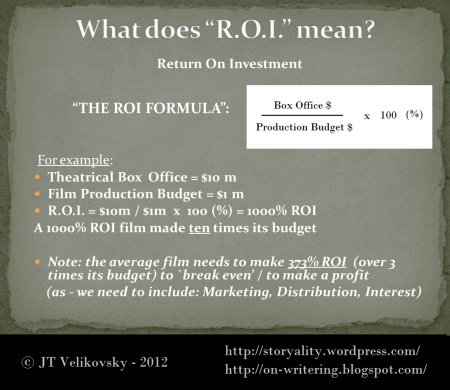









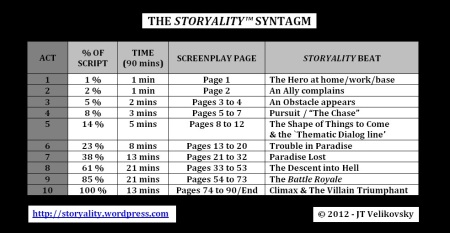










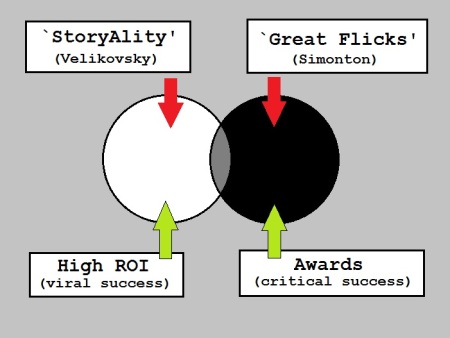








![Number of Scenes [red] vs Number of Minutes (or Screenplay pages) [blue]](https://storyality.files.wordpress.com/2013/05/number-of-scenes.png?w=450&h=364)








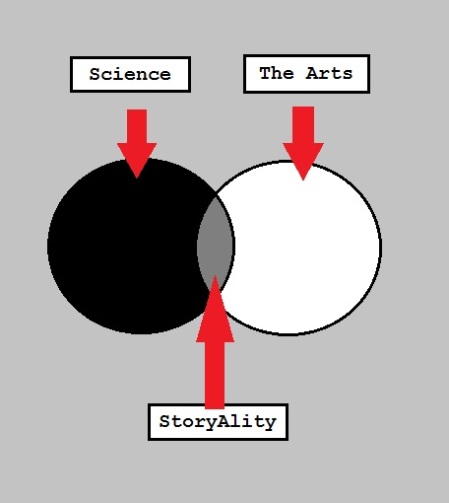







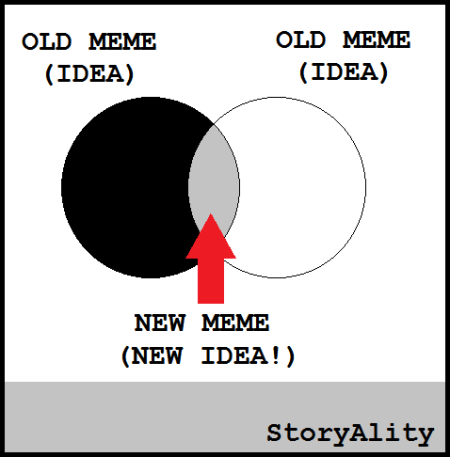


Pingback: StoryAlity #68 – StoryAlity Theory 3MT @ Interventions and Intersections 2013 | StoryAlity
Pingback: StoryAlity #69 – StoryAlity Theory 20-min Paper @ I-and-I Conference 2013 | StoryAlity
Pingback: StoryAlity #70 – Predictions of the StoryAlity Theory: a Top 20 RoI Film in January 2014 | StoryAlity
Pingback: StoryAlity #76 – The `new’ Film RoI numbers at The-Numbers.com | StoryAlity
Pingback: StoryAlity #116 – StoryAlity Theory @ `Interventions and Intersections’ 2014 (UWS PG Conference) | StoryAlity
Pingback: StoryAlity #116 – StoryAlity Theory @ `Interventions and Intersections’ 2014 (UWS PG Conference) | StoryAlity
Pingback: StoryAlity #3B – Trailers of the Top 20 RoI Movies | StoryAlity
Pingback: StoryAlity #100A – The 3 Universal Laws of Holon/Partons | StoryAlity
Pingback: StoryAlity #100A – The 3 Universal Laws of Holon/Partons | StoryAlity
Pingback: StoryAlity#71C(i) – Consil-ience – and Vertical Integra-tion | StoryAlity
Pingback: StoryAlity#150 – Key Findings from the StoryAlity PhD on High-RoI Movies | StoryAlity